Examining the Effects of Suction and Nonlinear Strength Envelopes on the Stability of a High Plasticity Clay Slope
Abstract
:1. Introduction
2. Background
2.1. Landslides in High-Plasticity Clays
2.2. Shear Strength Envelopes
2.3. Effects of Suction on Strength
3. Materials and Methods
3.1. Study Location
3.2. Soil Samples and Properties
3.3. Torsional Ring Shear Testing
4. Torsional Shear Testing Results
Comparison with Previous Studies
5. Slope Stability Analyses
5.1. Effect of Strength Envelope
5.2. Effect of Suction
6. Discussion
7. Conclusions
Author Contributions
Funding
Data Availability Statement
Acknowledgments
Conflicts of Interest
References
- Knights, M.J.; Montgomery, J.; Carcamo, P.S. Development of A Slope Failure Database for Alabama Highways. Bull. Eng. Geol. Environ. 2020, 79, 423–438. [Google Scholar] [CrossRef]
- Stallings, E.G. Investigation of Pavement and Subgrade Distress at Alabama Highway 5. Master’s Thesis, Auburn University, Auburn, AL, USA, 2016. [Google Scholar]
- Khan, M.S.; Hossain, S.; Ahmed, A.; Faysal, M. Investigation of A Shallow Slope Failure on Expansive Clay in Texas. Eng. Geol. 2017, 219, 118–129. [Google Scholar] [CrossRef]
- Szabo, E.W.; Osborne, W.E.; Copeland, C.W., Jr.; Neathery, T.L. Geologic Map of Alabama, Geological Survey of Alabama Special Map 220, Scale 1:250,000. 1988. Available online: https://ngmdb.usgs.gov/Prodesc/proddesc_55859.htm (accessed on 30 October 2021).
- Skempton, A.W. First-Time Slides in Over-Consolidated Clays. Géotechnique 1970, 20, 320–324. [Google Scholar] [CrossRef]
- Holtz, R.D.; Kovacs, W.D.; Sheahan, T.C. An Introduction to Geotechnical Engineering, 2nd ed.; Pearson: Upper Saddle River, NJ, USA, 2011. [Google Scholar]
- Kennedy, L. Drained Residual Strength of Expansive Soils Causing Pavement Distress along Alabama Highway 5. Master’ s Thesis, Auburn University, Auburn, AL, USA, 2019. [Google Scholar]
- Jackson, D. Insitu Measurement of Pavement Distress and Causal Mechanisms in Expansive Soil along Alabama Highway 5. Master’ s Thesis, Auburn University, Auburn, AL, USA, 2016. [Google Scholar]
- Herman, J. Damage to Pavements from Expansive Clays: A Review of Behavior and Remediation Techniques. M.C.E. Research Paper, Auburn University, Auburn, AL, USA, 2015. [Google Scholar]
- Skempton, A.W. Slope Stability of Cuttings in Brown London Clay. In Selected Papers on Soil Mechanics; Thomas Telford Publishing: London, UK, 1984; pp. 241–250. [Google Scholar]
- Skempton, A.W. Residual Strength of Clays in Landslides, Folded Strata and the Laboratory. Géotechnique 1985, 35, 3–18. [Google Scholar] [CrossRef]
- Bromhead, E. A Simple Ring Shear Apparatus. Ground Eng. 1979, 12, 40–44. [Google Scholar]
- ASTM D6467, Standard Test Method for Torsional Ring Shear Test to Determine Drained Residual Shear Strength of Cohesive Soils. J. ASTM Int. 2013. [CrossRef]
- Stark, T.D.; Vettel, J.J. Bromhead Ring Shear Test Procedure. Geotech. Test. J. 1992, 15, 24–32. [Google Scholar] [CrossRef]
- Stark, T.D.; Eid, H.T. Slope Stability Analyses in Stiff Fissured Clays. J. Geotech. Geoenvirn. 1997, 123, 335–343. [Google Scholar] [CrossRef]
- Stark, T.D.; Eid, H.T. Drained Residual Strength of Sohesive Soils. J. Geotech. Geoenviron. 1994, 120, 856–871. [Google Scholar] [CrossRef]
- Mesri, G.; Shahien, M. Residual Shear Strength Mobilized in First-Time Slope Failures. J. Geotech. Geoenviron. 2003, 129, 12–31. [Google Scholar] [CrossRef]
- Stark, T.D.; Hussain, M. Empirical Correlations: Drained Shear Strength for Slope Stability Analyses. J. Geotech. Geoenviron. 2013, 139, 853–862. [Google Scholar] [CrossRef] [Green Version]
- Eid, H.T.; Rabie, K.H. Fully Softened Shear Strength for Soil Slope Stability Analyses. Int. J. Geomech. 2017, 17, 04016023. [Google Scholar] [CrossRef]
- Stark, T.D.; Fernandez, R. Fully Softened Shear Strength Measurement and Correlations. Geotech. Test. J. 2020, 43, 1201–1215. [Google Scholar] [CrossRef]
- Lade, P.V. The Mechanics of Surficial Failure in Soil Slopes. Eng. Geol. 2010, 114, 57–64. [Google Scholar] [CrossRef]
- Duncan, J.M.; Wright, S.G.; Brandon, T.L. Soil Strength and Slope Stability; John Wiley & Sons: Hokoben, NJ, USA, 2014. [Google Scholar]
- Hou, T.S.; Xu, G.L.; Shen, Y.J.; Wu, Z.Z.; Zhang, N.N.; Wang, R. Formation Mechanism and Stability Analysis of The Houba Expansive Soil Landslide. Eng. Geol. 2013, 161, 34–43. [Google Scholar] [CrossRef]
- Yilmaz, I.; Karacan, E. A Landslide in Clayey Soils: An Example from the Kızıldag Region of the Sivas-Erzincan Highway (Sivas-Turkey). Environ. Geosci. 2002, 9, 35–42. [Google Scholar] [CrossRef]
- Stephens, I.; Branch, A. Testing Procedure for Estimating Fully Softened Shear Strengths of Soils Using Reconstituted Material; Engineer Research and Development Center Vicksburg MS Geotechnical and Structures Lab: Vicksburg, MS, USA, 2013. [Google Scholar]
- VandenBerge, D.R.; Duncan, J.M.; Brandon, T.L. Fully Softened Strength of Natural and Compacted Clays for Slope Stability. In Proceedings of the Geo-Congress 2013: Stability and Performance of Slopes and Embankments III, San Diego, CA, USA, 3–7 March 2013; pp. 221–233. [Google Scholar]
- Schofield, A.N.; Wroth, P. Critical State Soil Mechanics; McGraw-Hill London: London, UK, 1968; Volume 310. [Google Scholar]
- Crabb, G.; Atkinson, J. Determination of Soil Strength Parameters for The Analysis of Highway Slope Failures. In Proceedings of the Slope Stability Engineering Developments and Applications, Proceedings of the International Conference on Slope Stability Organized by the Institution of Civil Engineers, Isle of Wight, UK, 15–18 April 1991; pp. 13–18. [Google Scholar]
- Lupini, J.; Skinner, A.; Vaughan, P. The Drained Residual Strength of Cohesive Soils. Geotechnique 1981, 31, 181–213. [Google Scholar] [CrossRef]
- Dunkerley, D. A Study of Long-Term Slope Stability in the Sydney Basin, Australia. Eng. Geol. 1976, 10, 1–12. [Google Scholar] [CrossRef]
- Skempton, A.W. Long-Term Stability of Clay Slopes. Géotechnique 1964, 14, 77–102. [Google Scholar] [CrossRef] [Green Version]
- Tiedemann, B. Über die Schubfestigkeit Bindiger Böden; Preuß. Versuchsanst. f. Wasserbau u. Schiffbau: Berlin, Germany, 1937; Available online: https://link.springer.com/chapter/10.1007/978-3-7091-7999-4_1 (accessed on 30 October 2021).
- Haefeli, R. Investigation and Measurements of the Shear Strengths of Saturated Cohesive Soils. Geotechnique 1951, 2, 186–208. [Google Scholar] [CrossRef]
- Taha, M.R.; Hossain, M.K.; Mofiz, S.A. Effect of Suction on the Strength of Unsaturated Soil. In Proceedings of the Advances in Unsaturated Geotechnics, Denver, CO, USA, 5–8 August 2000; pp. 210–221. [Google Scholar]
- Leong, E.-C.; Abuel-Naga, H. Contribution of Osmotic Suction to Shear Strength of Unsaturated High Plasticity Silty Soil. Geomech. Energy Environ. 2018, 15, 65–73. [Google Scholar] [CrossRef]
- Fredlund, D.G.; Morgenstern, N.R.; Widger, R.A. The Shear Strength of Unsaturated Soils. Can. Geotech. J. 1978, 15, 313–321. [Google Scholar] [CrossRef]
- Fredlund, D.G.; Rahardjo, H. Soil Mechanics For Unsaturated Soils; John Wiley & Sons: Hoboken, NJ, USA, 1993. [Google Scholar]
- Fredlund, D.G. Unsaturated Soil Mechanics in Engineering Practice. J. Geotech. Geoenviron. 2006, 132, 286–321. [Google Scholar] [CrossRef] [Green Version]
- Khalili, N.; Khabbaz, M. A Unique Relationship for χ for the Determination of the Shear Strength of Unsaturated Soils. Geotechnique 1998, 48, 681–687. [Google Scholar] [CrossRef]
- Vanapalli, S.K.; Fredlund, D.G.; Pufahl, D.E. The Relationship Between the Soil-water Characteristic Curve and the Unsaturated Shear Strength of A Compacted Glacial Till. Geotech. Test. J. 1996, 19, 259–268. [Google Scholar] [CrossRef]
- Bhandary, N.P.; Yatabe, R. Ring Shear Tests on Clays of Fracture Zone Landslides and Clay Mineralogical Aspects. In Progress in Landslide Science; Springer: Berlin/Heidelberg, Germany, 2007; pp. 183–192. [Google Scholar]
- Stark, T.D. Discussion of “Correlations for Fully Softened Shear Strength Parameters”. Geotech. Test. J. 2017, 40. [Google Scholar] [CrossRef]
- Rocscience SLIDE Version 9.0. Available online: http://www.rocscience.com (accessed on 30 October 2021).
- Christensen, D.; Bonaquist, R.; Jack, D. Evaluation of Triaxial Strength as A Simple Test for Asphalt Concrete Rut Resistance; 2000; Available online: https://trid.trb.org/view/666395 (accessed on 30 October 2021).
- Khan, S.; Ivoke, J.; Nobahar, M. Coupled Effect of Wet-Dry Cycles and Rainfall on Highway Slope Made of Yazoo Clay. Geosciences 2019, 9, 341. [Google Scholar] [CrossRef] [Green Version]
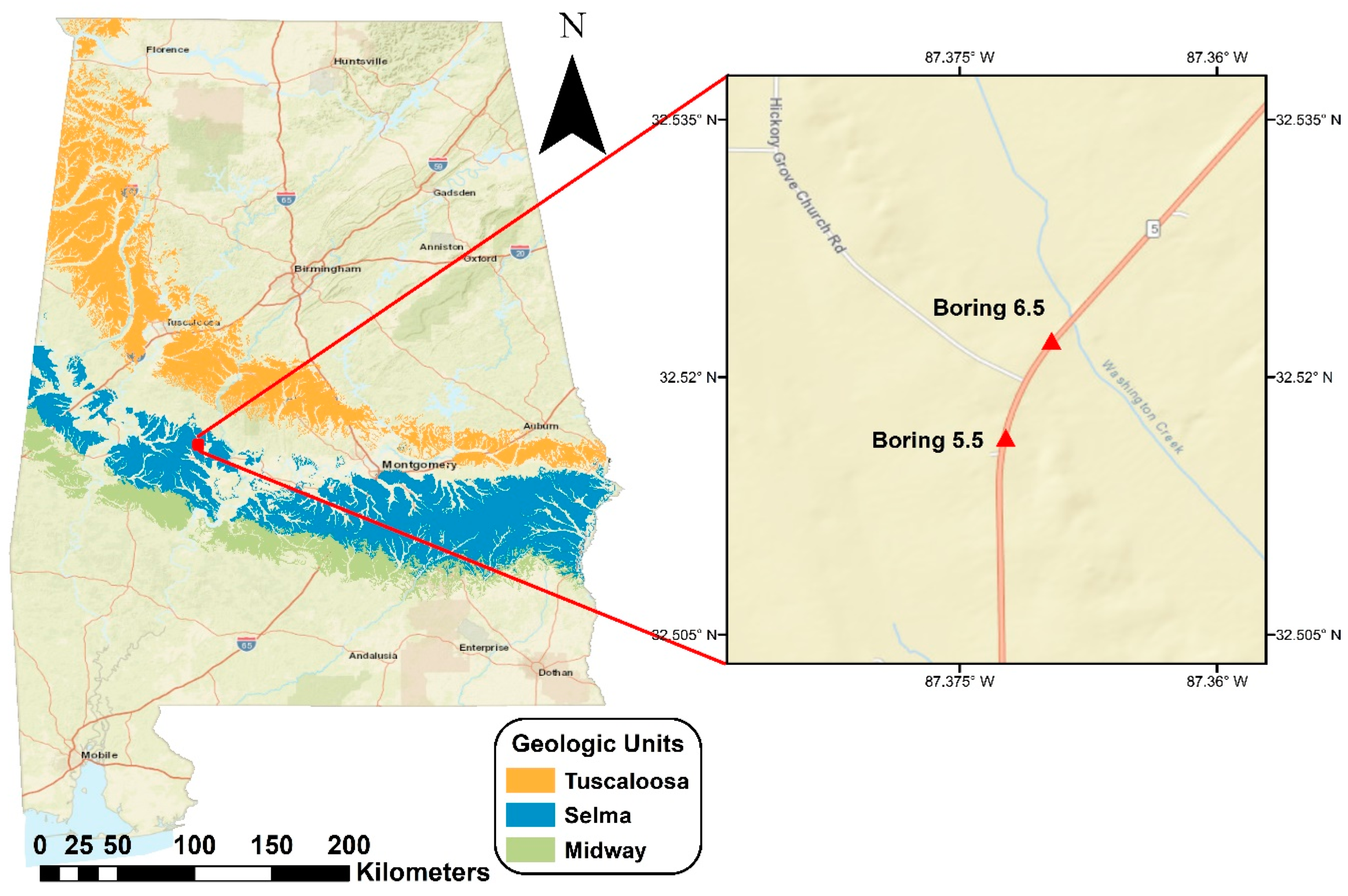
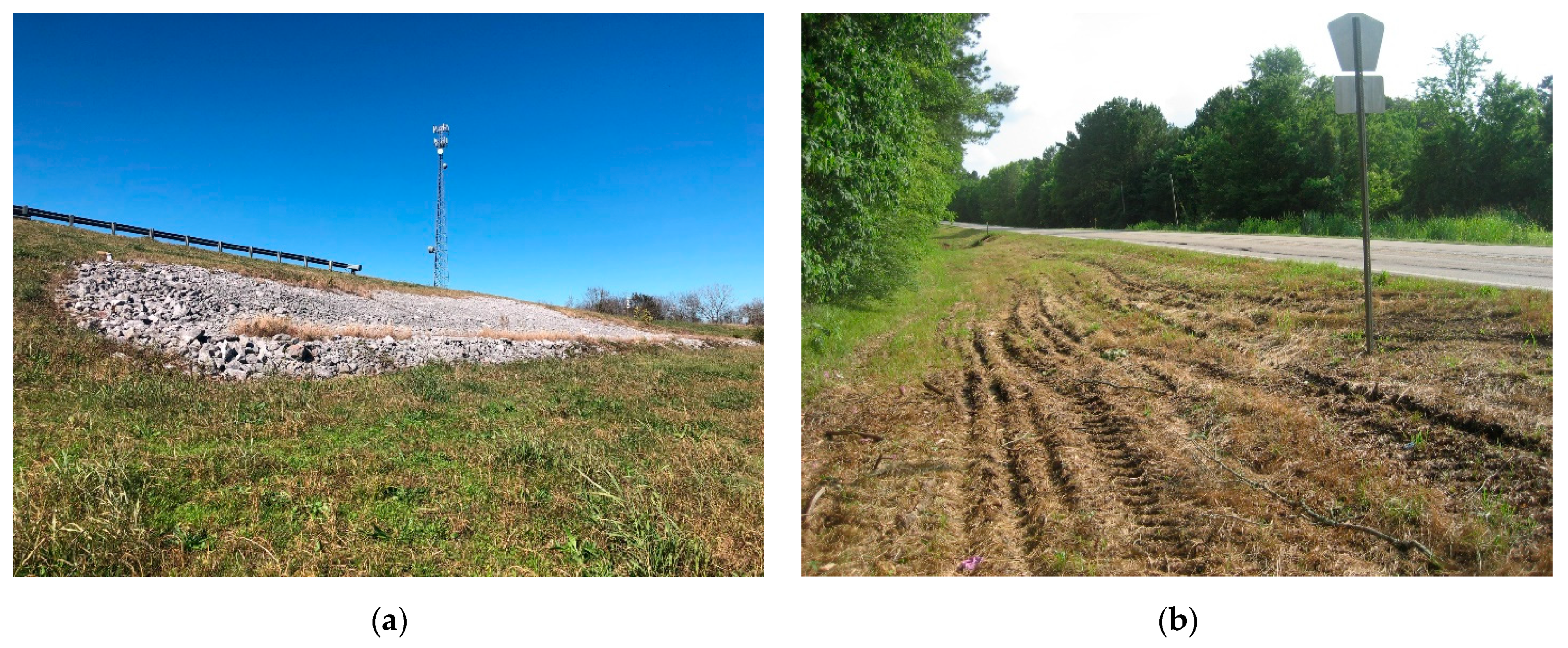
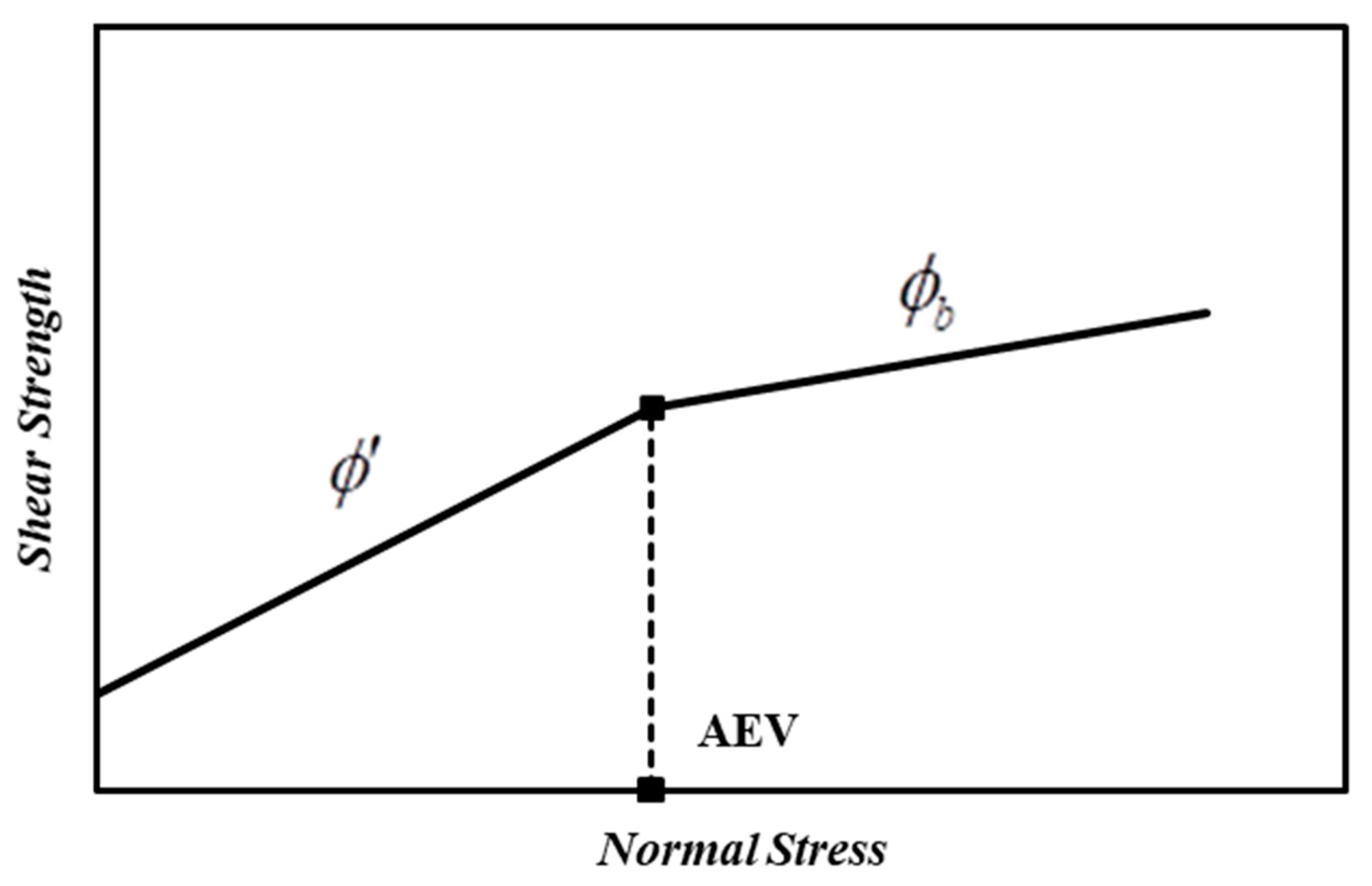
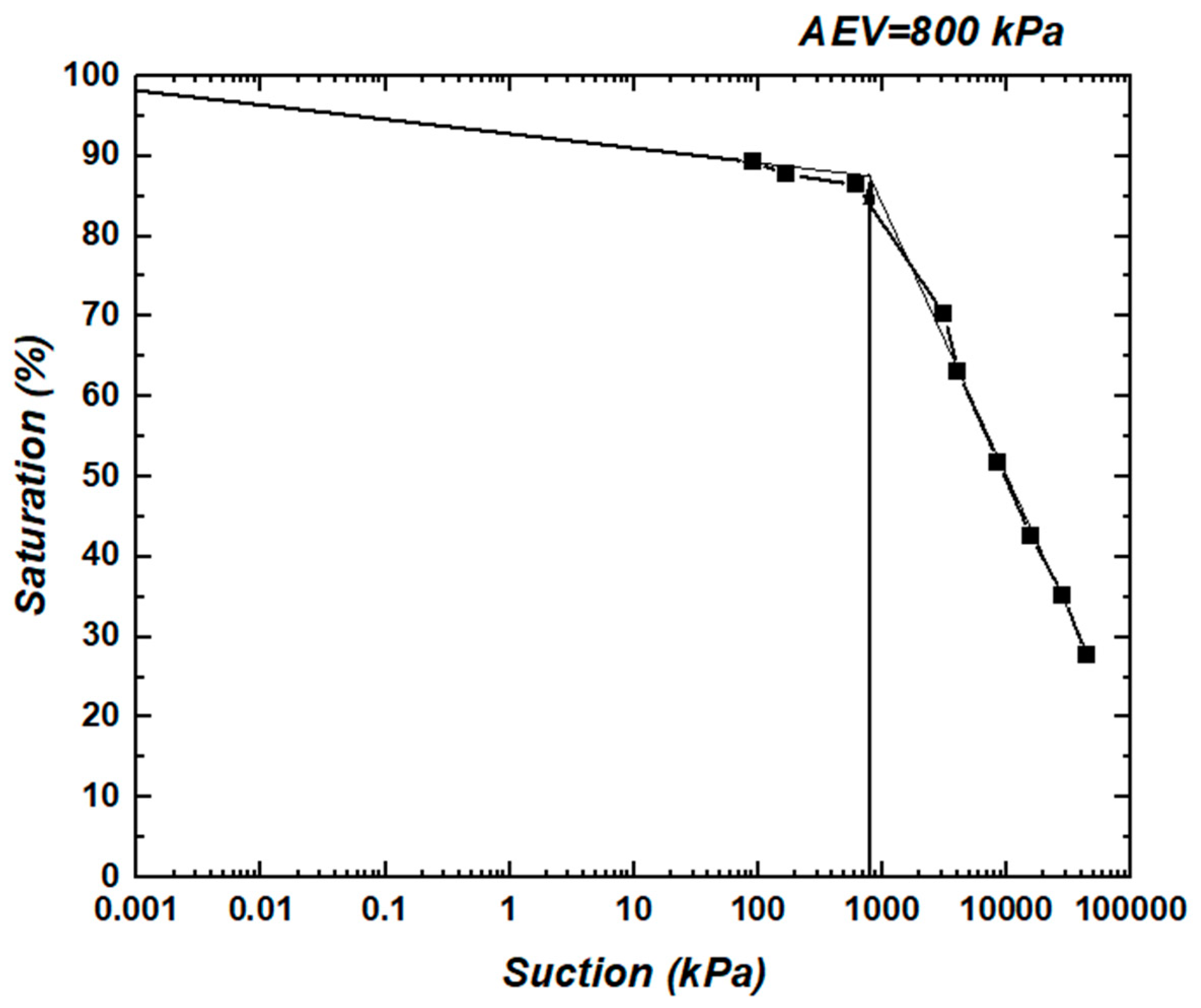
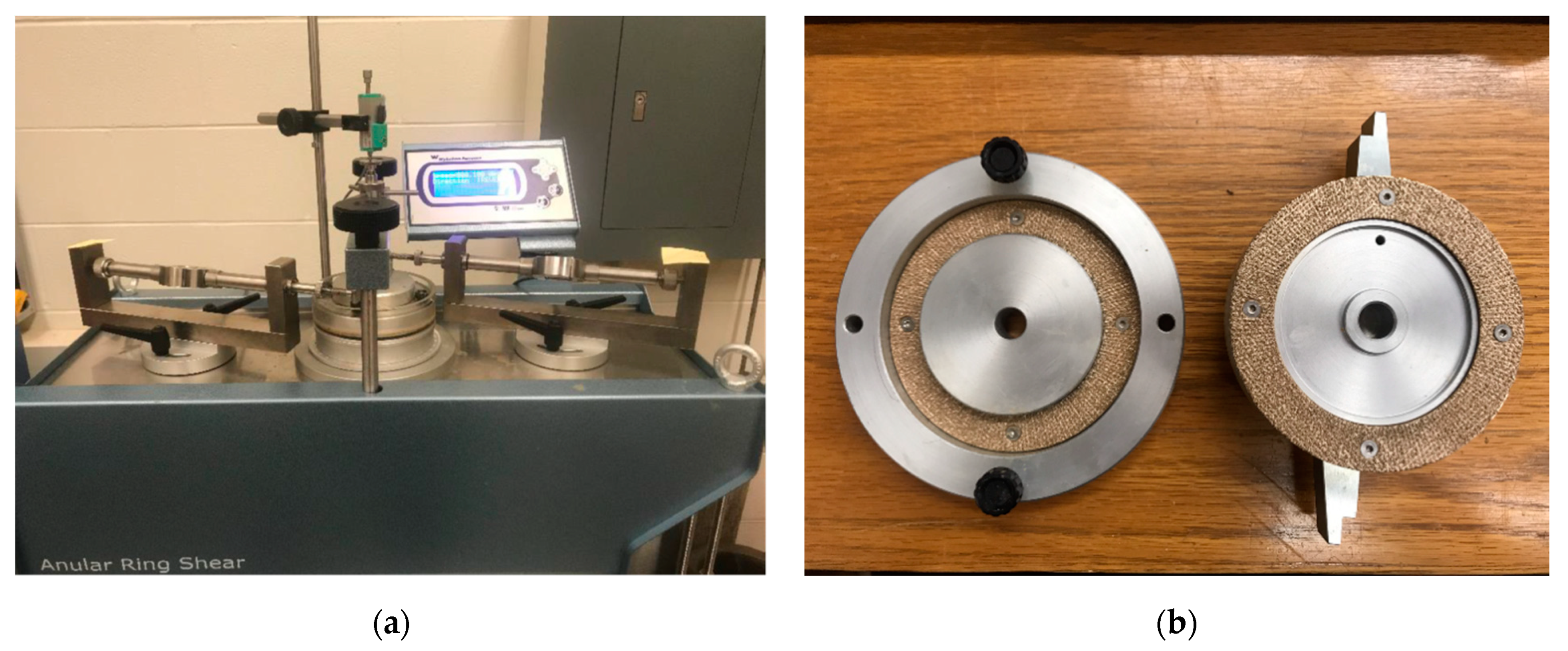
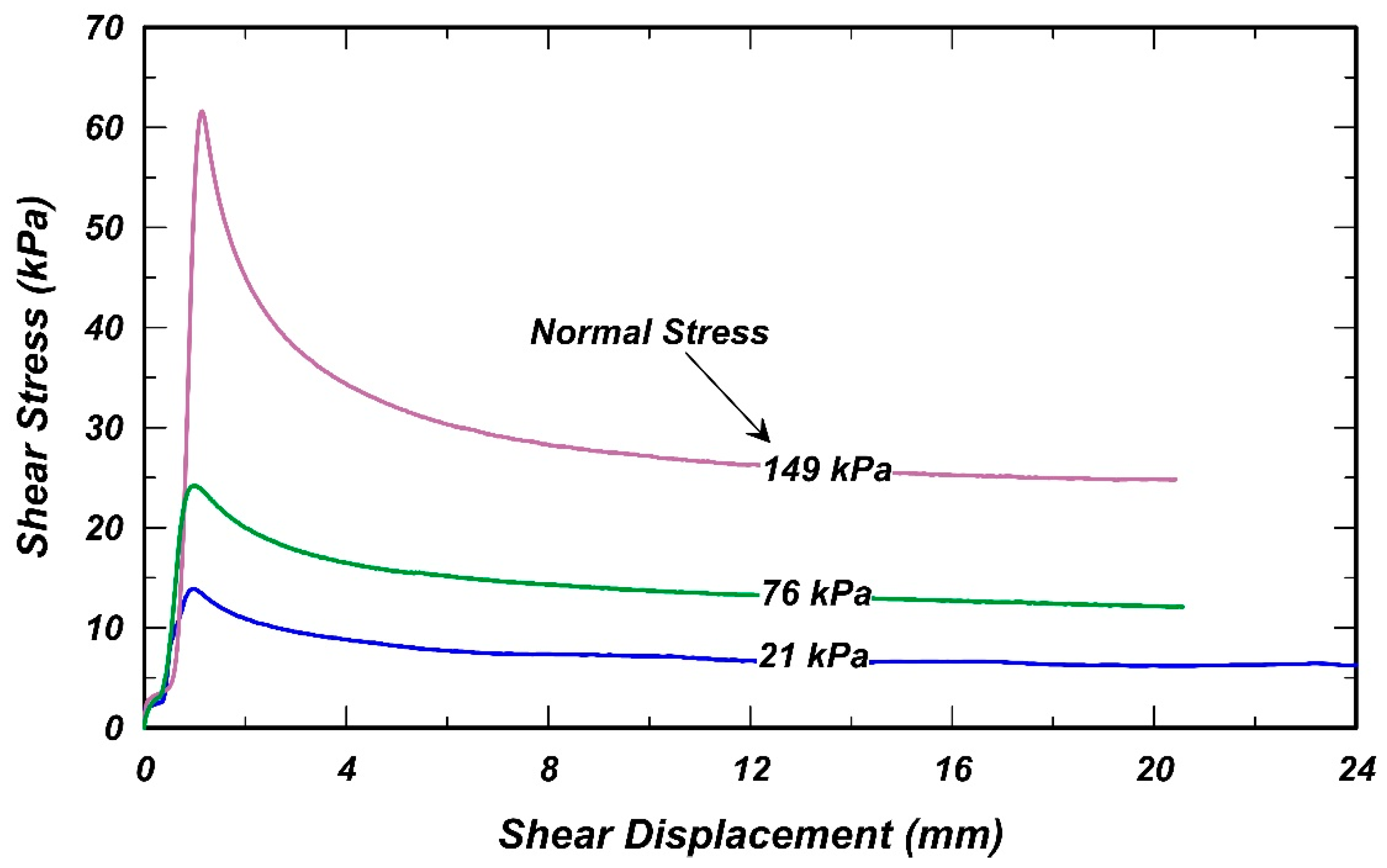
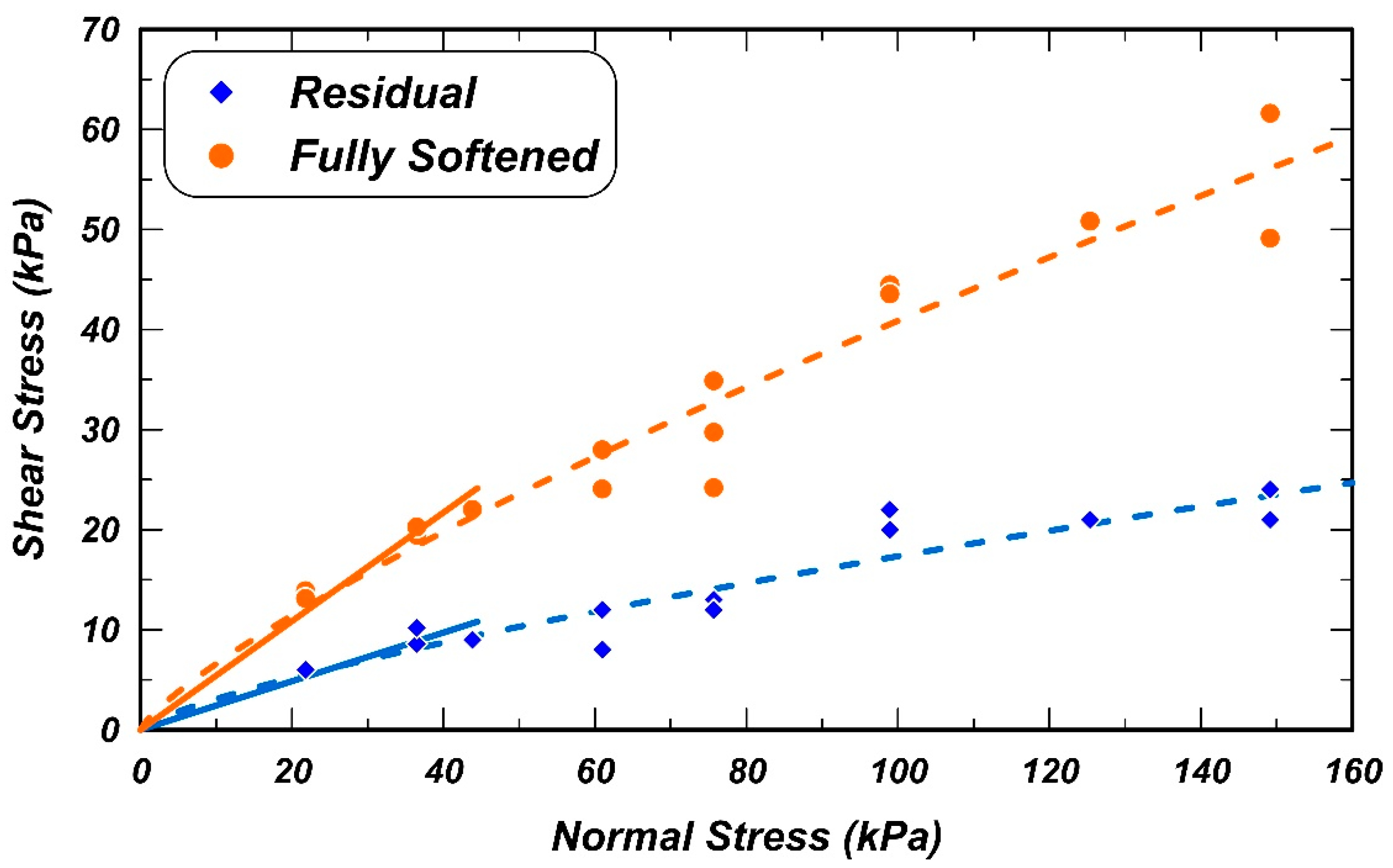
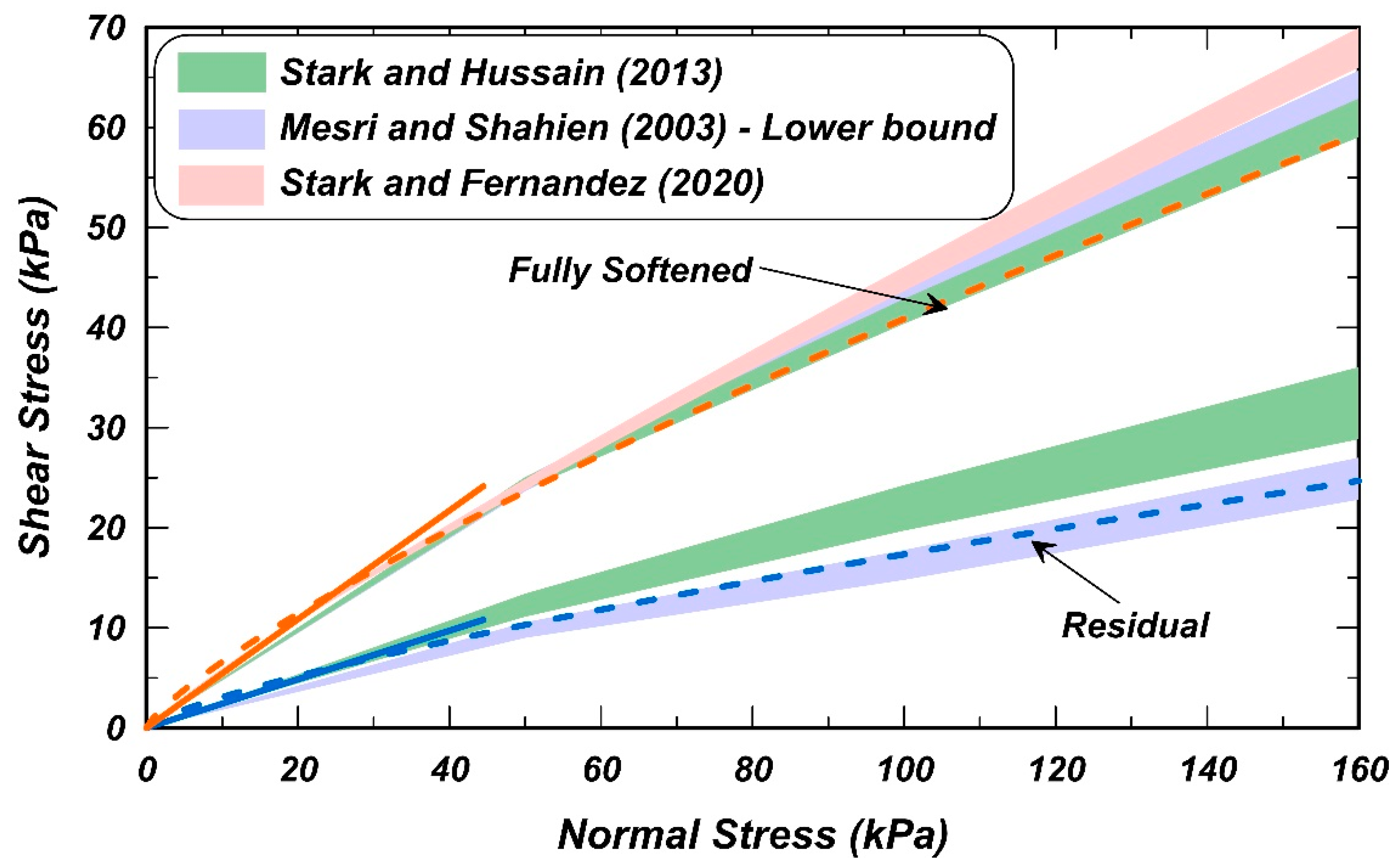
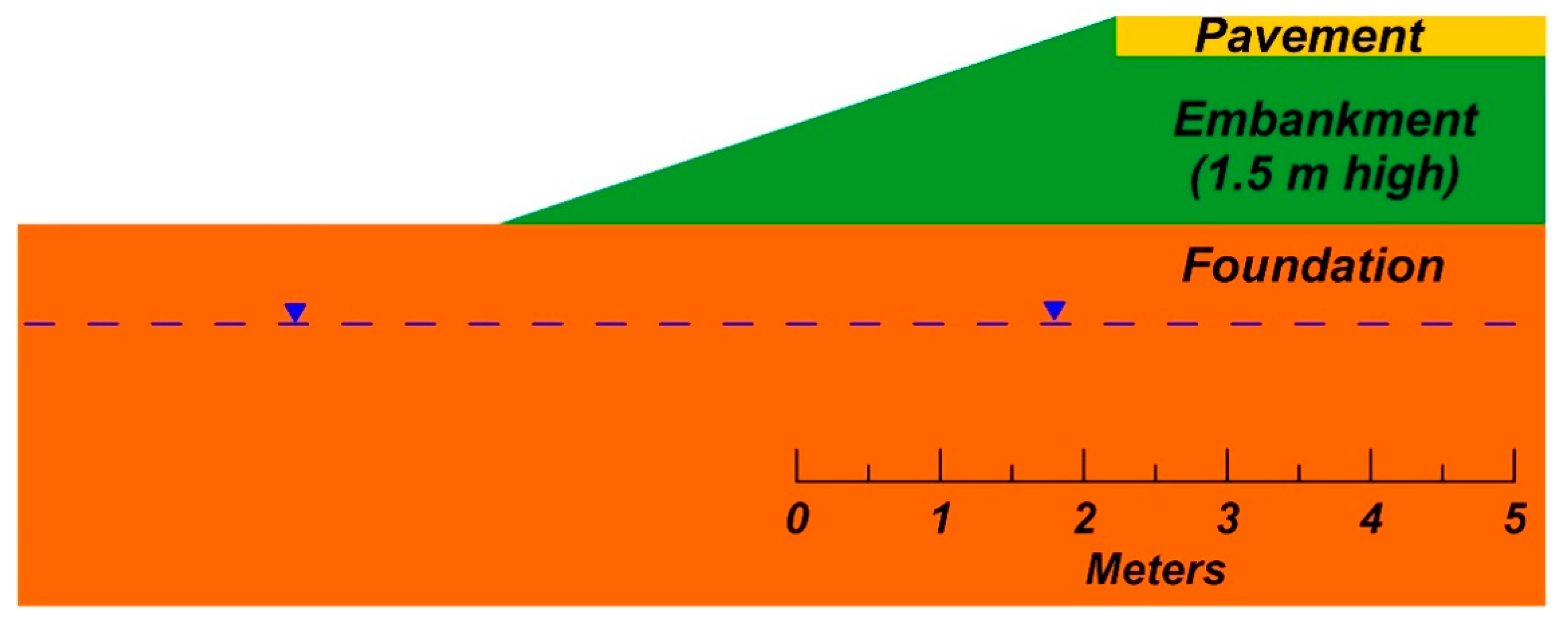

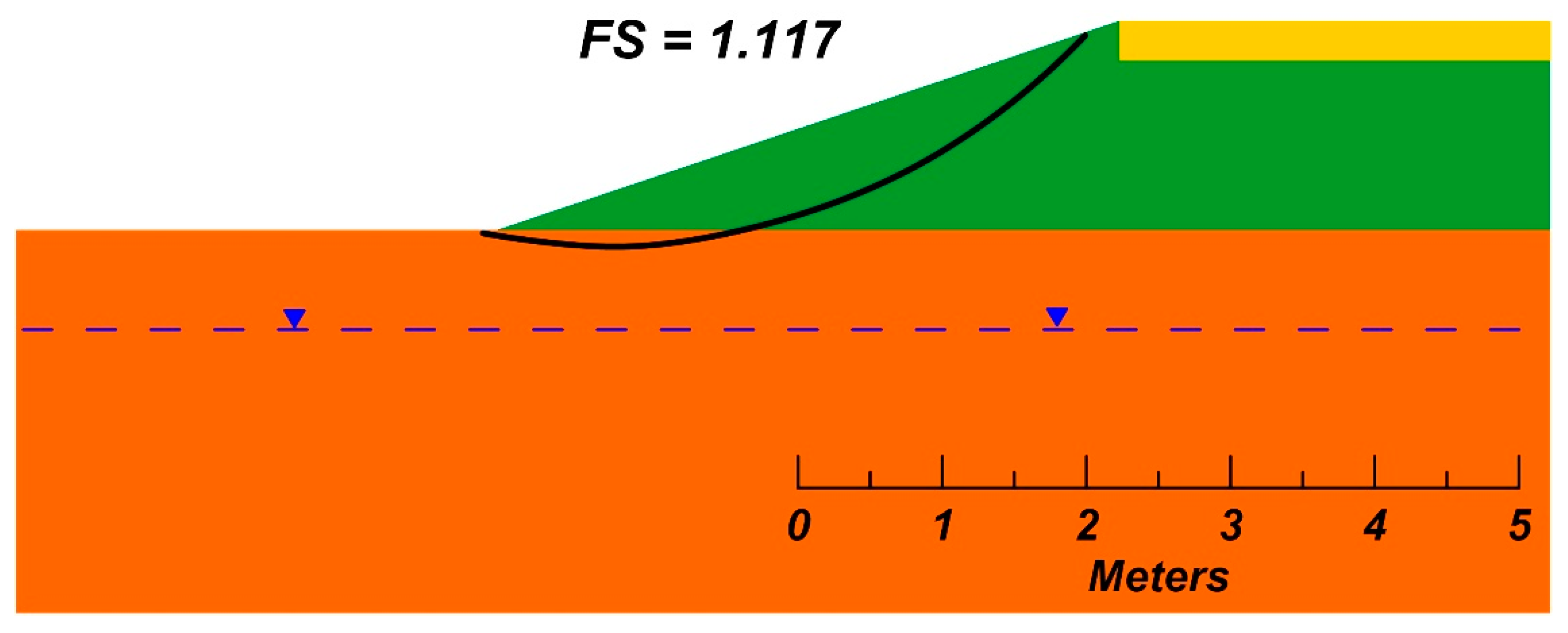
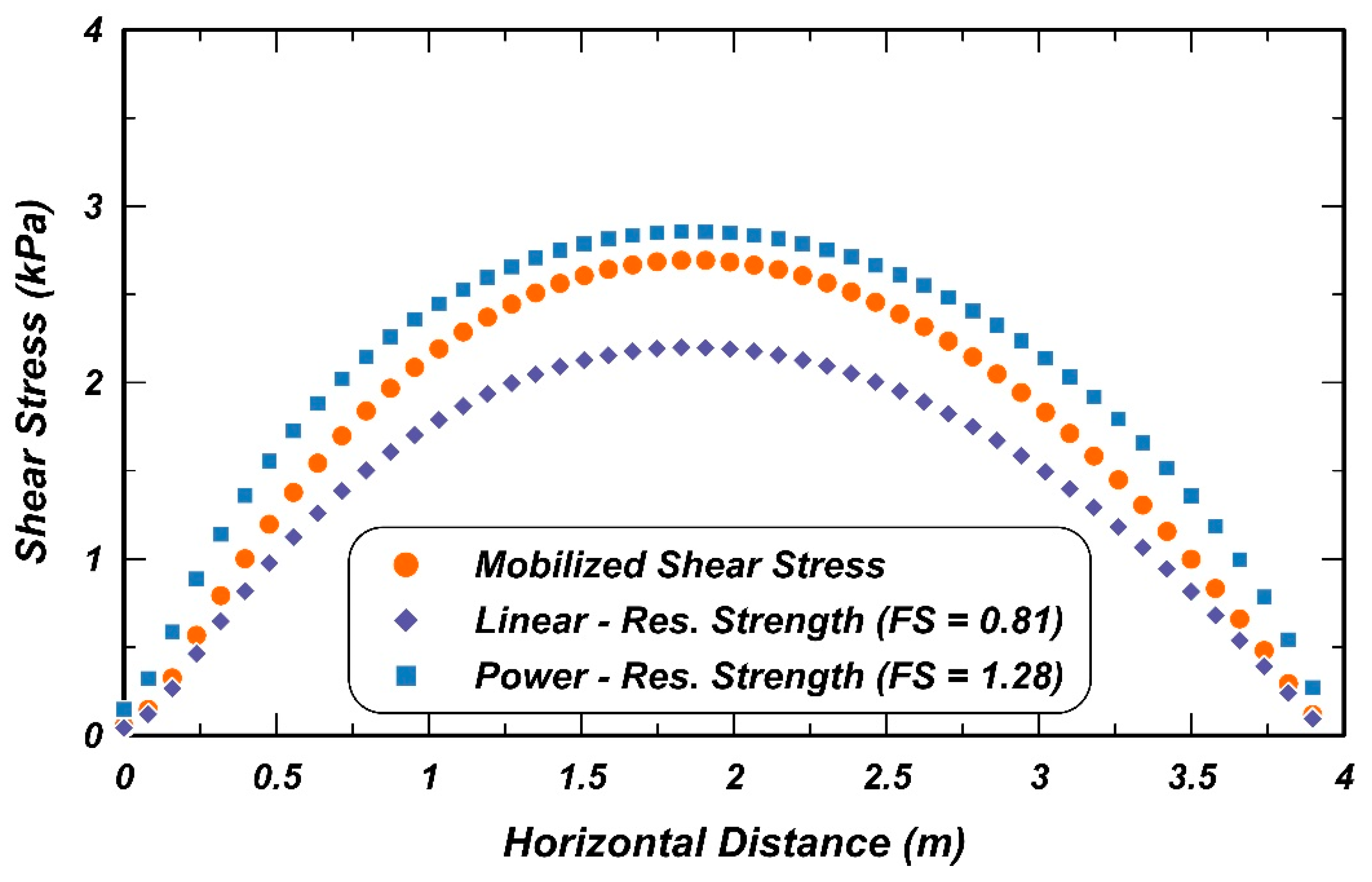


| Soil Type (USCS) | Liquid Limit | Plasticity Index | Natural Water Content (%) | Dry Density (kN/m3) | Fines Content (%) | Average Clay Fraction (%) |
|---|---|---|---|---|---|---|
| Fat Clay (CH) | 71–86 | 47–60 | 28–40% | 12.7–14.2 | 60–96% | 54% |
| Envelope Types | Strength Envelope (kPa) | R2 |
|---|---|---|
| Residual Strength-Linear Fit | 0.983 | |
| Residual Strength-Power Fit | 0.875 | |
| Fully Softened Strength-Linear Fit | 0.994 | |
| Fully Softened Strength-Power Fit | 0.929 |
| Soil Layer | Density (kN/m3) | Drained Friction Angle (Deg) | Cohesion (kPa) |
|---|---|---|---|
| Pavement | 22.8 | 34 | 369 |
| Embankment | 18.1 | Fully softened and residual strength envelopes shown in Table 2 | |
| Foundation | 18.3 | Fully softened and residual strength envelopes shown in Table 2 | |
| Factor of Safety | ||||
|---|---|---|---|---|
| Fully Softened Strength-Linear Fit | Fully Softened Strength-Power Fit | Residual Strength-Linear Fit | Residual Strength-Power Fit | |
| No suction | 1.629 | 2.344 | 0.726 | 1.117 |
| No suction—0.5 m minimum depth | 1.819 | 2.344 | 0.810 | 1.117 |
| With suction | 3.320 | - | 1.480 | - |
Publisher’s Note: MDPI stays neutral with regard to jurisdictional claims in published maps and institutional affiliations. |
© 2021 by the authors. Licensee MDPI, Basel, Switzerland. This article is an open access article distributed under the terms and conditions of the Creative Commons Attribution (CC BY) license (https://creativecommons.org/licenses/by/4.0/).
Share and Cite
Xuan, M.; Montgomery, J.; Anderson, J.B. Examining the Effects of Suction and Nonlinear Strength Envelopes on the Stability of a High Plasticity Clay Slope. Geosciences 2021, 11, 449. https://doi.org/10.3390/geosciences11110449
Xuan M, Montgomery J, Anderson JB. Examining the Effects of Suction and Nonlinear Strength Envelopes on the Stability of a High Plasticity Clay Slope. Geosciences. 2021; 11(11):449. https://doi.org/10.3390/geosciences11110449
Chicago/Turabian StyleXuan, Mengwei, Jack Montgomery, and J. Brian Anderson. 2021. "Examining the Effects of Suction and Nonlinear Strength Envelopes on the Stability of a High Plasticity Clay Slope" Geosciences 11, no. 11: 449. https://doi.org/10.3390/geosciences11110449





